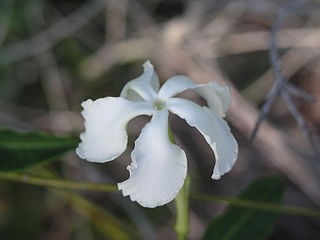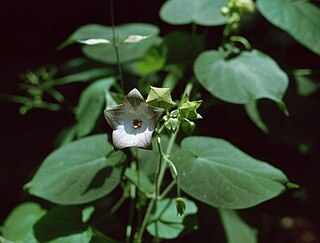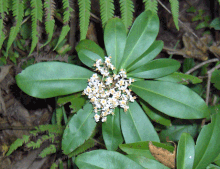Chamguava is a genus of the botanical family Myrtaceae, first described as a genus in 1991. It is native to southern Mexico and Central America.
- Chamguava gentlei(Lundell) Landrum - Chiapas, Belize, Guatemala, Honduras
- Chamguava musarum(Standl. & Steyerm.) Landrum - Guatemala
- Chamguava schippii(Standl.) Landrum - Guerrero, Chiapas, Belize, Guatemala, Panama
Metalepis is a genus of plant in family Apocynaceae first described as a genus in 1866. It is native to northern South America, Central America, Mexico, Florida, and the West Indies.
- Metalepis albifloraUrb. - Colombia, Ecuador, Fr Guiana, N Brazil, West Indies
- Metalepis cubensis(A. Rich.) Griseb. - Florida, Cuba, Belize, Veracruz in Mexico
- Metalepis gentryiMorillo - Ecuador
- Metalepis haughtii(Woodson) Morillo - Ecuador
- Metalepis peraffinis(Woodson) Morillo - S Mexico, Central America, Colombia
- Metalepis prevostiaeMorillo - French Guiana, Panama

Fernaldia is a genus of flowering plants in the family Apocynaceae, first described as a genus in 1932. It is native to Mexico and Central America.
Prionosciadium thapsoides is a plant species native to the States of Veracruz and México, in the República de México, as well as Guatemala.
Prionosciadium humile is a species native to the Mexican state of Nuevo León. It is a biennial herb with trifoliate leaves, each leaflet palmately 3-lobed and almost cleft.
Prionosciadium nelsonii is a plant species known from the Mexican states of Chiapas and Morelos. It is a biennial herb with a large taproot. Leaves are compound with narrowly lanecolate leaflets, some of them with narrow, tapering lobes. The inflorescence is a compound umbel at the top of the stem.
Prionosciadium bellii is a plant species endemic to the Mexican State of Michoacán. It occurs in brush areas at elevations of 1,800–2,100 m (5,900–6,900 ft).
Prionosciadium lilacinum is a plant species native to the Mexican States of Jalisco and Nayarit. It is common along sunlit roadsides and other disturbed habitats in the region.
Arracacia filipes is a plant species native to the Mexican State of Durango. It grows in moist, shaded areas in forests and canyons at elevations of 2,000–2,700 m (6,600–8,900 ft).
Arracacia papillosa is a plant species native to the Mexican State of Jalisco. It occurs on steep slopes in oak forests at elevations of 2,000–3,000 m (6,600–9,800 ft).
Arracacia macvaughii is a plant species native to the Mexican State of Querétaro. It is known only from the type locale, in a fir forest at an elevation of approximately 3100 m.
Eryngium jaliscense is a plant species native to the Mexican State of Jalisco. It grows in scattered populations in pine forests and other shaded slopes at elevations of 1,200–1,600 m (3,900–5,200 ft).
Fraxinus dubia is a plant species native to Mexico and Central America. It has been reported from Guatemala, Belize, Honduras, Costa Rica, Chiapas and Veracruz.
Pinochia monteverdensis is a plant species native to Costa Rica, Guatemala and Oaxaca.

Echites is a genus of flowering plants in the family Apocynaceae, first described as a genus in 1756. It is primarily native to Mexico, Central America, the West Indies, and the US State of Florida.
Laubertia, a genus of plants in the family Apocynaceae, was first described 1844. They are native to Mexico, Central America, and South America.
Laxoplumeria is a genus of plants in the family Apocynaceae, first described as a genus in 1947. They are native to Panama and South America.

Fischeria is a plant genus in the family Apocynaceae, first described as a genus in 1813. It is native to South America, Central America, southern Mexico, and the West Indies.

Polystemma is a genus of flowering plants of the family Apocynaceae first described as a genus in 1844. It is native to Mexico and Central America.
- Polystemma guatemalense(Schltr.) W.D.Stevens - from Nayarit to Costa Rica
- Polystemma mirandaeLozada-Pérez - Guerrero, Oaxaca, Puebla
- Polystemma viridifloraDecne. - Michoacán, Veracruz, Oaxaca, Chiapas
Pherotrichis is a plant genus in the family Apocynaceae, first described as a genus in 1838. It is native to Mexico and Arizona.
- Pherotrichis leptogeniaB.L.Rob. - Jalisco
- Pherotrichis mixtecanaBrandegee - Oaxaca
- Pherotrichis schaffneriA.Gray - San Luis Potosí, Cochise County in Arizona





